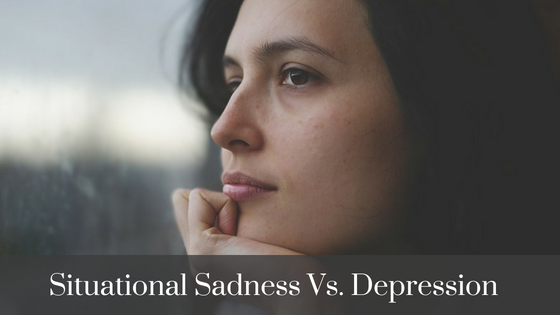The National Institute of Mental Health estimates that there are over 16 million people in the United States who have had at least one depressive episode in a given year. Statistics show that of these people, many do not receive treatment for their depression. For example, a recent study, published by JAMA Internal Medicine, screened more than 46,000 adults for depression and found that 8.4 percent tested positive for depression. However, less than 30 percent of these actually sought treatment. Healthline.com states that less than 50% of the people living with depression globally will receive treatment.
Recognizing the difference between situational sadness and depression is important. The following chart will help you note the differences. The chart is a guideline only, and if you are concerned that you or a loved one might be depressed, be sure to contact a psychologist.
Situational Sadness VS. Depression: Understanding the Differences
SITUATIONAL SADNESS
Sadness- Feeling down over a recent event lasting for a short period of time.
Sadness- Procrastination from time to time due to momentary sad feelings
Sadness- Certain activities do not seem enjoyable to you anymore.
Sadness- You notice small wieght gain or loss of appetite after going through a traumatic event.
Sadness- Mild sleep disturbance for a short time.
Sadness- Some troubling or repetitive thoughts, especially when alone.
Sadness- Mild difficulty with concentration.
DEPRESSION
Depression- Feeling sadness over anything and everything for an extended period
Depression- Loss of motivation to do anything. (you cannnot get out of bed or you stop going to work or school).
Depression- Everything you do is less enjoyable.
Depression- Significant weight gain or loss and/or increase or decrease of appetite without an increase in daily activity.
Depression –Significant sleep disturbance over at least two weeks.
Depression- Great disturbance with repetitive or distressing thoughts, even when with other people.
Depression-Significant interference with work or school because of poor concentration
Types of Depression
There are many types of depression. Each has its own nuances and features. Diagnosis should only be made by a psychologist, medical doctor, or other trained mental health professional. If you think you may suffer from one of these types of depression, contact a professional immediately.
Major depression: Severe symptoms that interfere with the ability to work, sleep, study, eat, and enjoy life. An episode can occur only once in a person’s lifetime, but more often, a person has several episodes.
Persistent depressive disorder: A depressed mood that lasts for at least 2 years. A person diagnosed with the persistent depressive disorder may have episodes of major depression along with periods of less severe symptoms, but symptoms must last for 2 years.
Psychotic depression: Occurs when a person has severe depression plus some form of psychosis, such as having disturbing false beliefs or disturbed thinking patterns; a break with reality (delusions); or hearing or seeing upsetting things that others cannot hear or see (hallucinations).
Postpartum depression: Occurs when hormonal and physical changes from giving birth plus the responsibility of caring for a newborn become overwhelming. This condition is much more than the “baby blues” that most women experience postpartum. It is a serious but very treatable form of depression. It is estimated that 10 to 15 percent of women experience postpartum depression after giving birth.
Seasonal affective disorder (SAD): Is characterized by the onset of depression during the winter months, when there is less natural sunlight. The depression generally lifts during spring and summer. SAD may be effectively treated with light therapy, but nearly half of those with SAD do not get better with light therapy alone. Antidepressant medication and psychotherapy can reduce SAD symptoms, either alone or in combination with light therapy.
Bipolar disorder is a mood disorder where the person experiences episodes of extreme low moods (depression); but where they also experience (at least once in their life) extreme mood elevation (mania). Mania can manifest as extreme giddiness, elation, exuberance, anxiety or rage.
Adapted from: The National Institute of Mental Health’s Guide: Depression: What You Need To Know
Common Symptoms of Depression
If you experience several of the symptoms on this list for more than two weeks, you may be depressed. See a psychologist or other mental health professional for a diagnosis and treatment. Depression is a treatable condition.
- Persistent sad, anxious, or “empty” mood
- Feelings of hopelessness, or pessimism
- Irritability
- Feelings of guilt, worthlessness, or helplessness
- Loss of interest or pleasure in hobbies and activities
- Decreased energy or fatigue
- Moving or talking more slowly
- Feeling restless or having trouble sitting still
- Difficulty concentrating, remembering, or making decisions
- Difficulty sleeping, early-morning awakening, or oversleeping
- Appetite and/or weight changes
- Thoughts of death or suicide, or suicide attempts (Reach out for help right away if you experience these thoughts)
- Aches or pains, headaches, cramps, or digestive problems without a clear physical cause and/or that do not ease even with treatment
Discouraging things happen that may cause you to be down, such as a recent breakup, a job loss or even losing a family member. It’s normal to grieve or to feel sad over life’s misfortunes. However, if the pain you are feeling is not going away, seek help sooner than later. Never be ashamed to seek the help you need. One of the biggest misconceptions about it is that you will need to receive treatment or take medication for the rest of your life. Understand that every situation is different and there are many cases where treatment is for a limited period of time and then they discontinue treatment. If you have questions or are looking for someone to talk to, our psychologists would love to help.

